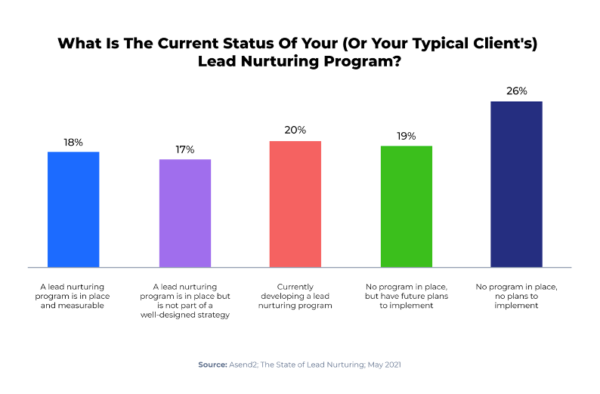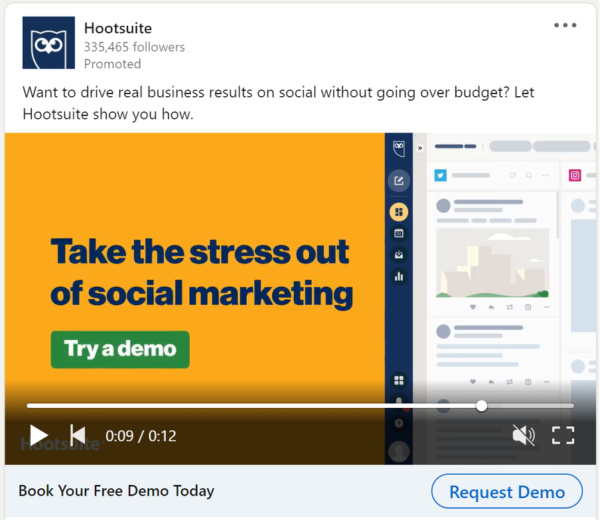
8 Lead Nurturing Best Practices for Account-Based Marketing

B2B customers are rarely ready to buy when you first engage with them. Even with a targeted account-based marketing (ABM) campaign that reaches best-fit customers, you still need to convince them that you’re the right solution.
An effective lead nurturing strategy can help you engage with every decision-maker at a target account, familiarize them with your brand, and move them toward the sale. In a recent survey by Ascend2, 84% of marketers either somewhat or strongly agree that allocating more resources to lead nurturing would improve conversion rates.
However, in spite of this, the same research found that 26% of marketing professionals had no formal lead nurturing program in place, nor did they have plans to implement one:

Whether you’ve only just started or already have a program up and running, this article will explore the best practices for lead nurturing to help you improve your process and get better results.
But first, let’s see why lead nurturing is such a vital part of ABM.
Why do we nurture target accounts as part of an ABM strategy?
Traditional lead generation programs typically call for marketers to attract as many leads as possible before qualifying them. An ABM strategy differs in that it’s based on identifying the best accounts to target and then reaching out to the individual decision-makers with a compelling message.
Marketers need to dedicate time and energy researching target accounts and reaching out to the right people with content tailored to their unique situation. As ABM is usually synonymous with winning large enterprise-level accounts, a lead nurturing strategy is needed to engage multiple decision-makers across long and potentially complex buying cycles.
The good news is that the research you carry out to identify those ideal accounts is the perfect foundation for a lead nurturing campaign. In-depth knowledge of an account and the individuals who form the buying committee allows you to create highly relevant, attention-grabbing messaging.
As a result, nurturing can shorten the sales cycle and establish meaningful customer relationships across the entire account. This ultimately leads to increased loyalty and a stronger sales pipeline.
With these benefits in mind, let’s examine the best practices for implementing lead nurturing in your ABM strategy.
1. Apply proper attribution and segmentation
Lead nurturing can be powerful, but only if tailored to the recipient. Before you get started, you must fully understand your accounts and what’s resonating with them.
The first step is proper attribution. By being able to accurately see what content the audience has engaged with (and how often they’ve engaged with it), you can learn more about the prospect and where they are in the buyer’s journey. In turn, this can be used to inform your subsequent nurturing to make it more effective.
From there, breaking down accounts into smaller segments makes it easier to create and personalize campaigns to their specific needs. For example, you could segment by demographics (e.g. job title), firmographic criteria (such as location or company size), technographic data (whether they use a competitor or a complementary solution), or how closely they match your ideal customer profile (ICP).
By using an ABM platform that collects accurate attribution data, you can also use nurture tracks—a predefined sequence of outreach and engagement—to further tailor your content based on where the account is in the buying process.
For example, a ‘welcome’ nurture track would be useful for accounts at the beginning of the sales funnel. For existing accounts, you could create a separate retention nurture track that highlights the value of an ongoing customer relationship.
2. Benchmark against your own conversions
Measurement is a key component of any ABM campaign, and that also applies to your lead nurturing. Analyzing how your content and messaging across different nurture tracks performs allows you to see what’s working and what doesn’t. From these insights, you can tweak and optimize future campaigns.
There are a number of different metrics you can look at to benchmark your lead nurturing. For example, you could measure velocity by looking at the time it takes to move through the campaign, from initial contact through to paying customer.
You could also look at how the volume of engagement changes. Are prospects at your chosen account viewing your ads, responding to your email campaigns, and downloading your content?
Ultimately, the main objective of any lead nurturing campaign is to convert the lead from a prospect into a customer, so measuring the conversion rate is essential. However, there are different conversion rates to consider, including:
- Overall conversion rate across all channels
- Acquisition conversion rate to measure individual channel performance
- Content-level conversion rate to discover the most effective content
- Campaign-level conversion rate
Comparing these various rates gives you greater insight into the different parts of your lead nurturing process, enabling you to make informed strategic decisions. You can then combine these figures with value-based metrics to ensure you have the full picture.
For example, you’d likely improve your overall conversion rate by hand-delivering your content, but this could push the customer acquisition cost (CAC) so high that it’s no longer cost-efficient. You could potentially reduce the length of your sales cycle with more aggressive messaging, but if that also significantly decreases your content-level conversion rate, it isn’t worth it.
Whichever metrics you use to benchmark your campaign, don’t get caught up in chasing industry benchmarks. While they can be useful when running competitive analyses, they can also be misleading or even discouraging.
The only conversion rate you should worry about beating is the one you had last month.
3. Match your messaging based on segments and nurture tracks
It’s important to deploy messaging that aligns with the sales funnel stage that your lead is in.
Your customers will go through the following stages:
- Top of the funnel (Awareness)
- Middle of the funnel (Consideration)
- Bottom of the funnel (Decision)
So, with the ‘welcome’ nurture track, you’d be looking to use top of the funnel (TOFU) messaging that builds awareness around the problems they face, rather than trying to sell your product straight away. Instead, your job is to become a trusted advisor helping them to overcome their challenges.
For middle of the funnel (MOFU) content, the goal should still be to educate the prospect. However, having earned their trust, you can now start to introduce your product and its benefits, positioning it as the ideal solution without being overly self-promotional. In other words, talk about your solution’s benefits rather than features or technology.
Finally, prospects at the bottom of the funnel (BOFU) are almost ready to make a decision. They just need to choose the right vendor. Your messaging here should give clear reasons to choose you over your competitors by using data and stats alongside case studies from existing customers that are similar to the target account.
4. Use a multi-channel approach to reach your accounts where they’re active
Even the best messaging delivered at the perfect time will be useless if the lead doesn’t see it. Using different channels increases the chances that your content marketing will be noticed, especially those where your prospect is active.
In addition, certain content is better suited to different channels. For example, a busy executive may not have time to attend a live webinar, while a targeted display ad could grab their attention.
Again, just as your message will change depending on where they are in the sales funnel, so might the channel. Earlier in the process, display ads and content syndication are usually ideal, while email marketing and social engagement may be more appropriate once you’re already on their radar.
As they move closer to the end of the nurture campaign, more exclusive channels such as live events (either online or in-person) and conversations between c-suite executives can be used to follow up and close the sale.
If possible, consider investing in an omnichannel approach. By coordinating multiple channels, rather than treating each channel as a separate entity, you can deliver seamless messaging where each touchpoint builds on the previous interaction. While it’s possible to manage each channel individually, the ability to design and execute your marketing campaigns from a single ABM platform makes the process easier for you and frictionless for the recipient.
5. Build out content worth reading
One of the cornerstones of ABM is delivering highly relevant content tailored to the prospect. For a lead nurturing campaign, that means creating content that’s genuinely helpful, not a thinly disguised sales pitch.
An intelligent ABM content syndication solution (such as Madison Logic) allows you to talk about your ICP’s problems and position yourself as an authority in your field, then start conversations with the people who are actively researching resolutions like yours.
To create truly relevant content, you must address what matters most to each individual on the buying committee. What keeps decision-makers at your target accounts awake at night?
Knowing the challenges they face is essential if you’re going to come up with an attention-grabbing message. Once you’ve identified those challenges, you can share that content across multiple channels, including LinkedIn.
For example, this ad from Dell Technologies speaks to a very specific audience (IT managers at small businesses) with a headline that refers to a specific challenge (security).

Likewise, this video ad from Hootsuite is also directed to a specific audience (in this case marketers) and refers to two relevant topics (stress and going over budget).

But how can you find out what topics to create content for that relate to your solution? The good news is accounts are eager to tell you what’s troubling them—you just need to know how to listen. B2B research and historical engagement are a treasure trove of information, revealing the most important topics that your accounts are researching and talking about.
The exact level of personalization you’d use to create your content will largely depend on the account tier. A one-to-one ABM strategy usually involves 100% unique content that may not apply to other organizations, such as landing pages, microsites, and physical items made exclusively for one account. However, even with a one-to-few or one-to-many ABM strategy, all content and messaging should still feel like it applies to them and their situation.
Going deeper, syndication can help you personalize elements of your campaigns to offer the same piece of content to multiple stakeholders. With a few key changes, the same infographic that was created for IT managers can be repurposed for end-users, business owners, or anyone else on the buying committee. As long as you tailor your ad creative and landing page copy to speak to the priorities of each individual, it can be repurposed.
By using a multi-channel ABM strategy, you can ensure that the content is delivered effectively by serving, starting, and stopping specific campaigns depending on where contacts are in the funnel.
6. Use intent data to serve the right content at the right time
Once you have the right content produced and ready to go, you can use intent data—information related to website visitors’ behaviors—to make sure it’s getting in front of your target accounts at the best possible time.
In practice, this means going beyond guessing what stage of the funnel a prospect is in to using data to discover who’s researching a particular topic and how interested they are. For example, what pages have they visited? How many times? How long did they spend on those pages? In effect you can become a mind reader, delivering content that answers your leads’ questions as they ask them.
As a side note, intent data can help with far more than just when to use your content; it can also confirm what channels your target accounts are using to research solutions. This includes who specifically at the account is carrying out the research, and the exact topics that interest them the most. It can also be used for pipeline acceleration, as we’ll see in the next section.
Of course, uncovering that intent data requires reliable data sources. By combining first-party data from your CRM and MAP with intent monitoring and additional proprietary data, ML Insights can identify the target accounts most likely to convert right now.
7. Accelerate the journey when accounts are actively looking for a solution.
As individuals move from awareness to consideration, they’ll eventually reach a point where they’re ready to make a decision. While the nurturing process shouldn’t be rushed, you should also be able to identify when the prospect is ready to take the next step, answering any questions they have and providing them with all the information they need.
Typically, this is done with content that demonstrates how your product would work in your prospect’s situation or benchmark data that allows your prospect to compare different solutions. This could be in the form of case studies, white papers, or eBooks that have been personalized to the priorities of each stakeholder.
This doesn’t have to be done manually though. For example, Journey Acceleration can be used to automatically move prospects into an appropriate nurture track to drive the most relevant message for the audience. By sending intent data back into your marketing automation platform, it’s easier to engage opportunities with relevant content that keeps them moving through the buying journey.
8. Align sales and marketing activities
One of the reasons ABM is such a powerful strategy is its basis on a strong alignment between sales and marketing. When both teams work together, collaborating on content and engaging with accounts, your lead nurturing becomes that much more effective.
However, actually getting sales and marketing teams to work together can be a significant challenge. According to LinkedIn, 9 in 10 sales and marketing professionals believe they’re misaligned across key areas, including process and content.
As a result, some recommend leaving lead nurturing exclusively to the sales team, arguing that consistent messaging from one team is the safest option. However, that’s missing a valuable opportunity. The same research from LinkedIn found that, despite the challenges, 90% believed that when initiatives and messages were aligned then the customer experience improved.
ABM involves reaching out to everyone on the buying committee, some of which may never speak directly with a sales rep. Aligning throughout the nurturing process allows for more effective messaging that is seen by all stakeholders.
So, how can you help foster collaboration between teams? The key is communication, ensuring that each team is fully aware of what’s going on throughout the campaign. For example, sales representatives need to be kept aware of the marketing content that a prospect has been sent.
Rather than being caught off guard, ensure that your sales team has access to the latest engagement and research insights from your marketing team, in a place that they’re likely to actually see it (such as their CRM).
Likewise, your marketing team needs to understand your sales process, ideally attending sales calls to acquire this knowledge firsthand. They should see how their content is being used and be quick to fill in any gaps identified by the sales team.
In addition, both teams need to agree on:
- Key definitions, including how accounts have been segmented
- Responsibilities, such as who will handle the delivery of content at each stage
- How success will be measured, both on a campaign and individual level
While it might be challenging, the benefits are more than worth it, with Forrester reporting that sales and marketing teams who are aligned on their ABM strategy can be up to 6 percentage points more likely to exceed their revenue goals.
Final thoughts
When dealing with multiple prospects across the buying committee, lead nurturing is an essential part of any ABM campaign.
This starts with a full understanding of who those leads are, the challenges they face, and where they are in the buying process. Combined with intent data, this can be used to deliver relevant content over the right channels at the right time, accelerating the sales cycle.
By aligning your sales and marketing teams, as well as benchmarking your conversions, you can optimize your lead nurturing campaigns to go and enjoy more successful results from your ABM.
To learn more about how the ML Platform can increase account engagement and accelerate the sales cycle for your best accounts, request your demo today.

